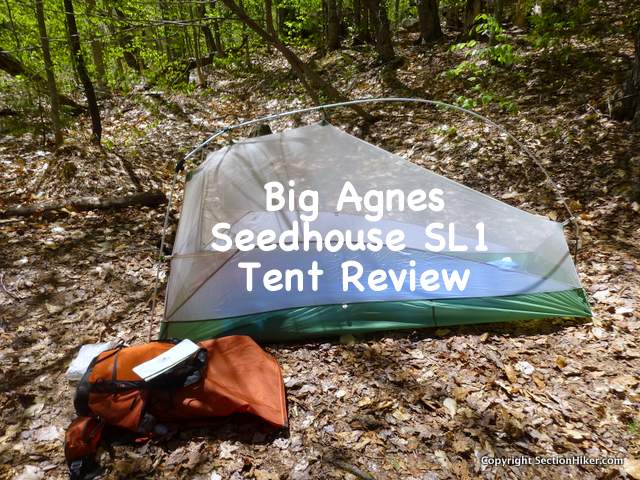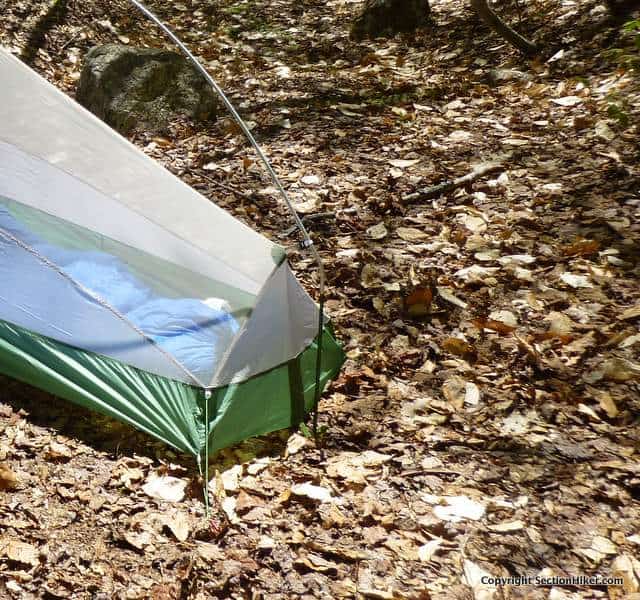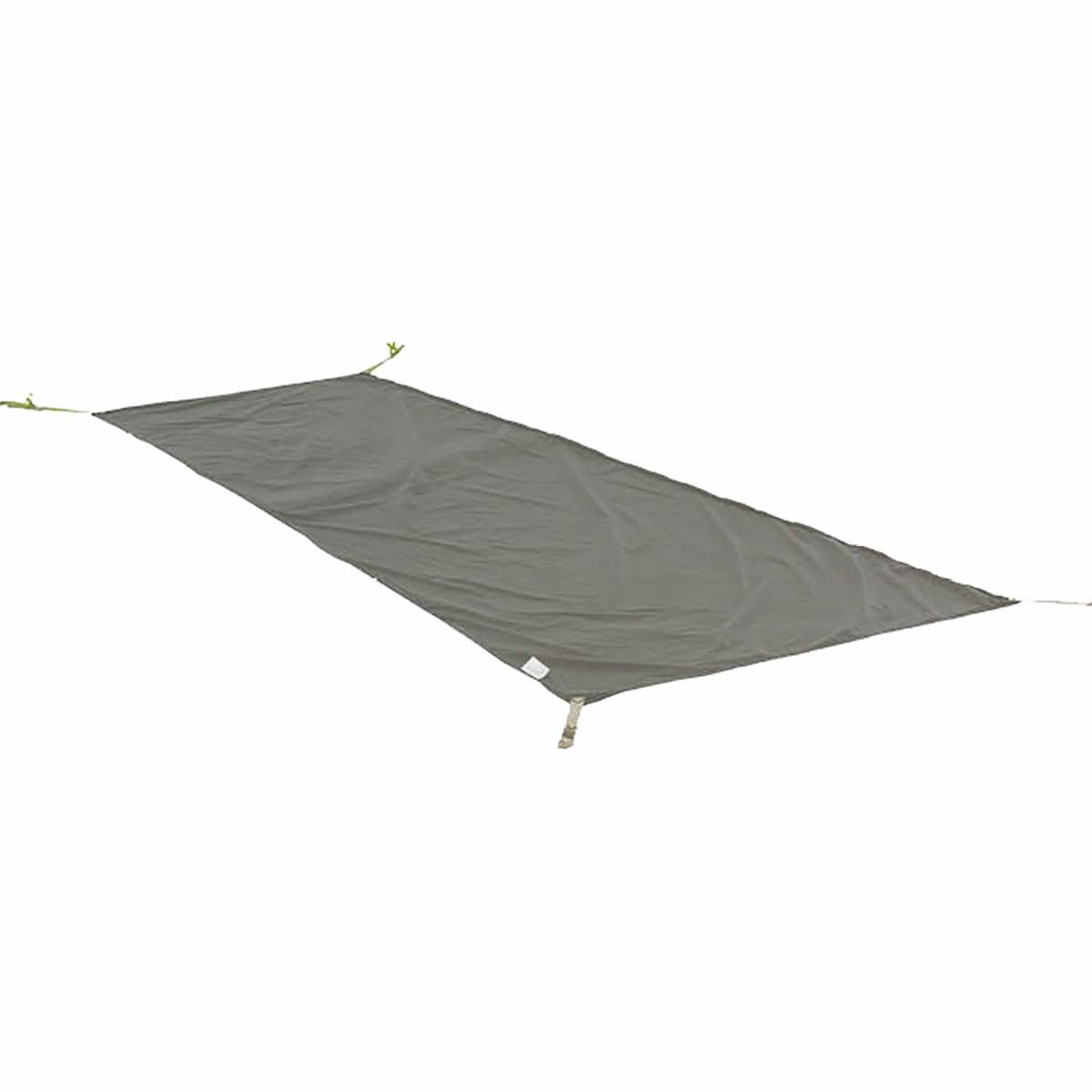
The Big Agnes Seedhouse SL 1 is an easy-to-setup one-person backpacking tent that weighs 2 lbs 8 oz. A long-time customer favorite, it has a roomy interior for people who want more interior living space to change clothes or hang out in without having to go to sleep. One of the notable things about this tent is that it’s built with thicker, more durable fabrics than some of Big Agnes’s ultralight backpacking tents. While that makes the Seedhouse a bit heavier, it is still a lightweight sub-3-pound tent, well-suited for an enthusiast backpacker who gets out a lot and wants a tent that is going to last without a lot of babying.
Big Agnes Seedhouse SL 1 Tent
Comfort
Ease of Setup
Weather Resistance
Durabilty
Weight
Packed Size
Specs at a Glance
- Weight: 2 lbs 8 oz total
- Fly: 16.5 oz
- Inner: 12.1 oz
- Poles: 11.4 oz
- Number of Doors: 1, front
- Minimum number of stakes to set up: 4, but 6-8 would be more optimal
- Type: Classified as “freestanding”, but that’s just not true.
- Interior Peak Height: 39″
- Interior Width: 37″ at door, tapering to 26″ at rear end.
- Interior Length: 84″
- Longest pole segment length: 16 and 1/8″ (important for bikepacking)
- Material:
- Floor: 30 denier nylon rip stop
- Fly: 30 denier nylon ripstop
- Mesh: 15 denier micromesh
Front Entry Tents – Pros and Cons
The Seedhouse SL 1 is a one-person tent with a front entry and vestibule. While the inner tent is fairly long, (84″) it’s designed to have you sleep with your head by the door. While the latest version of the Seedhouse SL 1 has been redesigned to have a more vertical front door and side walls, most of the living space is up front, tapering in terms of width and volume as you get closer to the rear of the tent. I mention this because some people hate to sleep with their head at the door end of a tent, even though it often has the best ventilation.

Front entry tents like the Seedhouse SL 1 are a lot like bivy sacks, because they’re narrow and directional with a definite head end and a foot end, although the Seedhouse SL 1 is wide enough and high enough that you can easily enter headfirst and turn around inside.
The Seedhouse SL 1 also has a front vestibule that provides extra gear storage and side windbreaks that are handy if you want to cook or make coffee with the door open while lying prone in your sleeping bag. While front vestibules provide valuable extra storage and a place to stash your pack and boots in a 1 person tent, they can also block the entrance unless you move them out-of-the-way. I don’t mind front entry tents, because they can often fit into tight spaces between trees or other obstructions where you could never fit a tent with side doors and a much wider vestibule area. But it’s helpful to consider the tradeoffs between the two tent orientations, particularly when choosing a 1 person solo tent.

Inner Tent
The Seedhouse SL inner tent is dead simple to pitch. It comes with a multi-segmented Y-shaped pole that you fit into grommets located at the front corners and rear of the tent. Plastic clips are used to suspend the mesh from the poles and take seconds to attach. You do need to stake out the two rear corners of the inner tent though to fully extend the floor and prevent the mesh/corners from collapsing over your feet. Those same stakes are also required to anchor the rain fly at the corners.
Big Agnes classifies the Seedhouse SL 1 as “freestanding” on their web site, but it just isn’t so. If you have to stake out the inners corners to get the full width and length of the inner tent and/or anchor the fly with tent stakes, it ain’t freestanding. (Someone has to award these Pinocchios.)

The inner tent has a high bathtub floor and is seam taped to make it waterproof. There are opaque panels along the sides for privacy and dust protection and then mesh overhead for ventilation. With a durable 30 denier ripstop nylon floor, there’s no need to use this tent with a foot print, saving you weight and money
Rain Fly
The rain fly, like the tent floor, is made using a 30 denier nylon ripstop. When draped over the inner tent, it looks rather lumpish and unattractive, Luckily you’ll use the tent, mostly a night, when it’s dark. :-)

The fly attaches to clips on the front corners of the inner tent, while guylines in the rear corners slip over the inner tent’s rear stakes. Another two stakes are required to secure the side wings of the front door to the ground. While optional, it’s helpful to stake out the side walls of the fly to promote ventilation. There are also glove clips on the inside of the rain fly that clip to the sides of the inner tent. These help increase the interior of the inner tent and air flow.

The inner tent is set back a bit from the top of the vestibule door, so you’re not drenched at night when it’s raining and you have to take a midnight stroll. The vestibule door also has two zippers, so you can open the top of the door to create a transom style vent to expel moisture and hot air. The side walls or wings of the front vestibule also provide a useful wind break for cooking or additional privacy.
Recommendation
The Big Agnes Seedhouse SL 1 is a lightweight backpacking tent made with durable fabrics and components. This newest redesign has increased the interior volume of the tent, with more vertical walls that add livability and comfort. The design of the front vestibule and the ability to create a transom vent also works well for increasing air flow and reducing internal condensation. While the Seedhouse SL 1 isn’t the lightest Big Agnes single person tent you can buy, it’s a very solid value, one that’s more affordable for your average Joe or Jane.
Disclosure: The author purchased this tent.
Compare 2 Prices
-

 Backcountry.com
Backcountry.com$60.00$39.00View -

 Amazon US$60.00View
Amazon US$60.00ViewAmazon.com Price: $60.00 (as of 04/26/2024 13:29 GMT-0400) Details
Product prices and availability are accurate as of the date/time indicated and are subject to change. Any price and availability information displayed on Amazon.com at the time of purchase will apply to the purchase of this product.
 SectionHiker.com Backpacking Gear Reviews and FAQs
SectionHiker.com Backpacking Gear Reviews and FAQs
So good you bought one for yourself – thanks for review!
Looks like a great little tent. Thanks for the review!